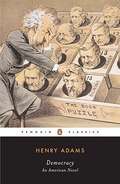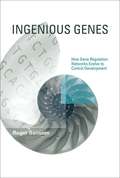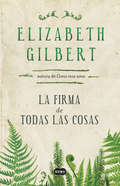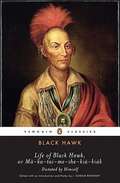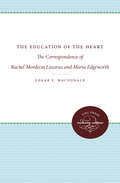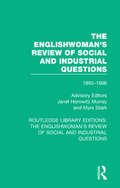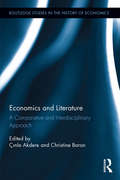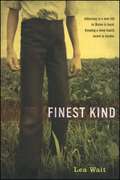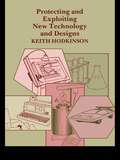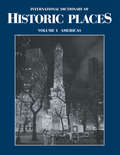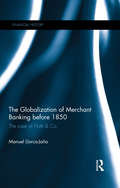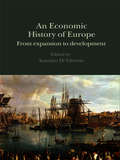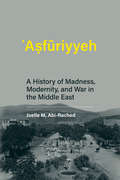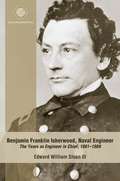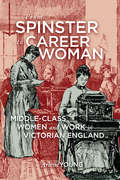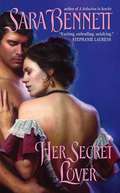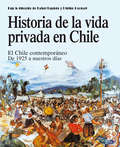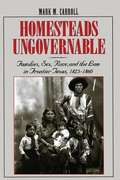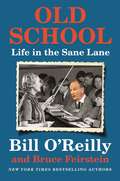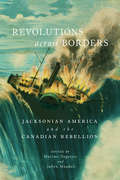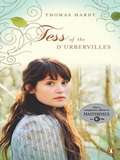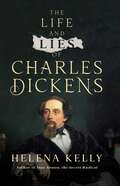- Table View
- List View
Democracy
by Henry AdamsThere are many editions of Democracy: An American Novel. This educational edition was created for self-improvement or in preparation for advanced examinations. The bottom of each page is annotated with a mini-thesaurus of uncommon words highlighted in the text, including synonyms and antonyms. Designed for school districts, educators, and students seeking to maximize performance on standardized tests, Webster's paperbacks take advantage of the fact that classics are frequently assigned readings. A running thesaurus at the bottom of each page is useful to students who are actively building their vocabularies in anticipation of taking PSAT®, SAT®, AP® (Advanced Placement®), GRE®, LSAT®, GMAT® or similar examinations. This edition exposes the reader to a maximum number of "difficult, and often encountered" words in examinations. Rather than supply a single synonym, many are provided for a variety of meanings, allowing readers to better grasp the ambiguity of the English language, and avoid using the notes as a pure crutch. Having the reader decipher a word's meaning within context serves to improve vocabulary retention and understanding. Each page covers words not already highlighted on previous pages. PSAT® is a registered trademark of the College Entrance Examination Board and the National Merit Scholarship Corporation neither of which sponsors or endorses this book; SAT® is a registered trademark of the College Board which neither sponsors nor endorses this book; GRE®, AP® and Advanced Placement® are registered trademarks of the Educational Testing Service which neither sponsors nor endorses this book, GMAT® is a registered trademark of the Graduate Management Admissions Council which is neither affiliated with this book nor endorses this book, LSAT® is a registered trademark of the Law School Admissions Council which neither sponsors nor endorses this product. All rights reserved.
Ingenious Genes
by Roger SansomEach of us is a collection of more than ten trillion cells, busy performing tasks crucial to our continued existence. Gene regulation networks, consisting of a subset of genes called transcription factors, control cellular activity, producing the right gene activities for the many situations that the multiplicity of cells in our bodies face. Genes working together make up a truly ingenious system. In this book, Roger Sansom investigates how gene regulation works and how such a refined but simple system evolved. Sansom describes in detail two frameworks for understanding gene regulation. The first, developed by the theoretical biologist Stuart Kauffman, holds that gene regulation networks are fundamentally systems that repeat patterns of gene expression. Sansom finds Kauffman's framework an inadequate explanation for how cells overcome the difficulty of development. Sansom proposes an alternative: the connectionist framework. Drawing on work from artificial intelligence and philosophy of mind, he argues that the key lies in how multiple transcription factors combine to regulate a single gene, acting in a way that is qualitatively consistent. This allows the expression of genes to be finely tuned to the variable microenvironments of cells. Because of the nature of both development and its evolution, we can gain insight into the developmental process when we identify gene regulation networks as the controllers of development. The ingenuity of genes is explained by how gene regulation networks evolve to control development.
La firma de todas las cosas
by Elizabeth GilbertIn The Signature of All Things, Elizabeth Gilbert returns to fiction, inserting her inimitable voice into an enthralling story of love, adventure and discovery. Spanning much of the eighteenth and nineteenth centuries, the novel follows the fortunes of the extraordinary Whittaker family as led by the enterprising Henry Whittaker--a poor-born Englishman who makes a great fortune in the South American quinine trade, eventually becoming the richest man in Philadelphia. Born in 1800, Henry’s brilliant daughter, Alma (who inherits both her father’s money and his mind), ultimately becomes a botanist of considerable gifts herself. As Alma’s research takes her deeper into the mysteries of evolution, she falls in love with a man named Ambrose Pike who makes incomparable paintings of orchids and who draws her in the exact opposite direction--into the realm of the spiritual, the divine, and the magical. Alma is a clear-minded scientist; Ambrose a utopian artist--but what unites this unlikely couple is a desperate need to understand the workings of this world and the mechanisms behind all life. Exquisitely researched and told at a galloping pace, The Signature of All Things soars across the globe--from London to Peru to Philadelphia to Tahiti to Amsterdam, and beyond. Along the way, the story is peopled with unforgettable characters: missionMaries, abolitionists, adventurers, astronomers, sea captains, geniuses, and the quite mad. But most memorable of all, it is the story of Alma Whittaker, who--born in the Age of Enlightenment, but living well into the Industrial Revolution--bears witness to that extraordinary moment in human history when all the old assumptions about science, religion, commerce, and class were exploding into dangerous new ideas. Written in the bold, questing spirit of that singular time, Gilbert’s wise, deep, and spellbinding tale is certain to capture the hearts and minds of readers.
Life of Black Hawk, or Ma-ka-tai-me-she-kia-kiak
by Black HawkA controversial figure in his day, Black Hawk was the leader of the Sauk American Indian tribe in the early 1800s. The son of the tribe s medicine man, Black Hawk s exploits as a warrior aided his rise to the status of tribal war leader. Here, Black Hawk chronicles his life as well as the story of his tribe, who were forced from their lands in Illinois during a series of skirmishes with American settlers in what came to be known as the Black Hawk War.
The Comic Almanack An Ephemeris in Jest and Earnest, Containing Merry Tales, Humerous Poetry, Quips, and Oddities Vol 1 (Classics To Go)
by VariousAn Ephemeris in Jest and Earnest, Containing Merry Tales, Humorous Poetry, Quips, and Oddities. Published in 1878.
The Education of the Heart: The Correspondence of Rachel Mordecai Lazarus and Maria Edgeworth
by Edgar E. MacdonaldIn 1815 a young North Carolina schoolteacher who was Jewish wrote to the celebrated Maria Edgeworth to ask why British novelists wrote in such a prejudiced manner about Jews. Maria was so moved by the letter that she set to work on a novel to make amends, and Harrington was published in 1817. The literary exchange that resulted grew into a friendship that lasted until Rachel's death in 1838, and the families continued to correspond until 1942.Originally published in 1977.A UNC Press Enduring Edition -- UNC Press Enduring Editions use the latest in digital technology to make available again books from our distinguished backlist that were previously out of print. These editions are published unaltered from the original, and are presented in affordable paperback formats, bringing readers both historical and cultural value.
The Englishwoman's Review of Social and Industrial Questions: 1895-1896 (Routledge Library Editions: The Englishwoman's Review of Social and Industrial Questions #28)
by Janet Horowitz Murray and Myra StarkThe Englishwoman’s Review, which published from 1866 to 1910, participated in and recorded a great change in the range of possibilities open to women. The ideal of the magazine was the idea of the emerging emancipated middle-class woman: economic independence from men, choice of occupation, participation in the male enterprises of commerce and government, access to higher education, admittance to the male professions, particularly medicine, and, of course, the power of suffrage equal to that of men. First published in 1984, this twenty-eighth volume contains issues from 1895 to 1896. With an informative introduction by Janet Horowitz Murray and Myra Stark, and an index compiled by Anna Clark, this set is an invaluable resource to those studying nineteenth and early twentieth-century feminism and the women’s movement in Britain.
Economics and Literature: A Comparative and Interdisciplinary Approach (Routledge Studies in the History of Economics)
by Ҫınla Akdere Christine BaronSince the Middle Ages, literature has portrayed the economic world in poetry, drama, stories and novels. The complexity of human realities highlights crucial aspects of the economy. The nexus linking characters to their economic environment is central in a new genre, the "economic novel", that puts forth economic choices and events to narrate social behavior, individual desires, and even non-economic decisions. For many authors, literary narration also offers a means to express critical viewpoints about economic development, for example in regards to its ecological or social ramifications. Conflicts of economic interest have social, political and moral causes and consequences. This book shows how economic and literary texts deal with similar subjects, and explores the ways in which economic ideas and metaphors shape literary texts, focusing on the analogies between economic theories and narrative structure in literature and drama. This volume also suggests that connecting literature and economics can help us find a common language to voice new, critical perspectives on crises and social change. Written by an impressive array of experts in their fields, Economics and Literature is an important read for those who study history of economic thought, economic theory and philosophy, as well as literary and critical theory.
Finest Kind
by Lea WaitWHAT CAN YOU DO WHEN YOU'RE TWELVE YEARS OLD AND YOUR WORLD IS FALLING APART? It's 1838. Jake's father has lost his job and his savings. Hearing of work in Maine, the family leaves their large home in Boston and heads north, taking with them a few furnishings—and a deep family secret. In Maine they find only a dirty, isolated farmhouse, and a job for Father that takes him away from home. "I'll have to depend on you," Jake's mother tells him. But how can Jake find food? How can he prepare for the dangerous cold of a Maine winter? How can he protect his mother—and his family's secret? Slowly, Jake learns the ways to survive, catching game and storing food for the long winter months. Nabby McCord, whose family also has a secret, helps him. So does Granny McPherson, who may be a witch. But when it comes to earning the money they need, Jake knows he's on his own. He shows his determination as the winter approaches, but does he have what it takes to bring his family together to face the future—and their past? Finest Kind is the powerful story of a boy who is forced to become a man and to learn the truth about courage, friendship, and secrets.
Peripheral Vision
by Zabet PattersonIn 1959, the electronics manufacturer Stromberg-Carlson produced the S-C 4020, a device that allowed mainframe computers to present and preserve images. In the mainframe era, the output of text and image was quite literally peripheral; the S-C 4020 -- a strange and elaborate apparatus, with a cathode ray screen, a tape deck, a buffer unit, a film camera, and a photo-paper camera -- produced most of the computer graphics of the late 1950s and early 1960s. At Bell Laboratories in Murray Hill, New Jersey, the S-C 4020 became a crucial part of ongoing encounters among art, science, and technology. In this book, Zabet Patterson examines the extraordinary uses to which the Bell Labs SC-2040 was put between 1961 and 1972, exploring a series of early computer art projects shaped by the special computational affordances of the S-C 4020. The S-C 4020 produced tabular data, graph plotting and design drawings, grid projections, and drawings of axes and vectors; it made previously impossible visualizations possible. Among the works Patterson describes are E. E. Zajac's short film of an orbiting satellite, which drew on the machine's graphic capacities as well as the mainframe's calculations; a groundbreaking exhibit of "computer generated pictures" by Béla Julesz and Michael Noll, two scientists interested in visualization; animations by Kenneth Knowlton and the Bell Labs artist-in-residence Stan VanDerBeek; and Lillian Schwartz's "cybernetic" film Pixillation.Arguing for the centrality of a peripheral, Patterson makes a case for considering computational systems not simply as machines but in their cultural and historical context.
Protecting and Exploiting New Technology and Designs
by K. HodkinsonThe protection of intellectual property rights has become a major concern in recent years. The opportunities being seized, or lost, in areas such as computer software or biotechnology have captured most of the headlines but in every research facility, whatever the subject, there is an increased awareness of the importance to R & D management of a more commercial attitude. Keith Hodkinson has run Government sponsored "professional updating" courses for academic and industrial researchers and business executives. The practical questions raised there and the advice found most useful have all helped to make this guide a down-to-earth source of help which will be of immediate, profitable use to its readers. Appendices to the book as well as giving lists of useful names and addresses to contact also contain examples of draft letters, contracts and record forms and licensing negotiating checklists.
The Americas: International Dictionary of Historic Places
by Trudy Ring Robert M. Slakin Sharon La BodaFirst Published in 1996. Routledge is an imprint of Taylor & Francis, an informa company.
The Globalization of Merchant Banking before 1850: The case of Huth & Co.
by Manuel Llorca-Ja�aLondon merchant bankers emerged during the 1820s in the wake of financial turmoil caused by the wars of American Independence, the Napoleonic campaigns and the Anglo-American war of 1812. Though the majority of merchant bankers remained cautious in their affairs, Huth & Co established an impressive global network of trade and lending, dealing with over 6,000 correspondents in more than seventy countries. Based on archival research, this comparative study provides a new chronology of early nineteenth-century commercial and financial expansion.Huth & Co. were truly market-makers and key intermediaries of commodities and capital flows in the international economy. This is an important example of a firm shaping globalisation well before the transport and communication revolution of the last quarter of the nineteenth century. But rather than a case study, this is a comparative study concerned with the commercial and financial activities of the leading merchant-bankers of the periodThis book will be of great interest to business and economic historians interested in the nature of the early decades of the first globalization.
An Economic History of Europe
by Antonio Di VittorioAn Economic History of Europe provides students with a comprehensive introduction to European economic history from the fifteenth century to the present day. Individual chapters offer brief references to previous historical periods and events, with special attention given to core themes concerning economic development, and an analysis of their change through time and space. Core themes examined in each period include: the increasing prominence of industry international trade demand and supply dynamics agriculture. The unique structure of this text enables students not only to gain a firm grounding in the long-term evolution of the European economy, but also provides an historical overview of the economic development of individual countries. Individual contributors analyze the shift from the modern to the contemporary period and offer a broad explanation of the historical roots of the problems that face today's economic development. This key text is indispensable reading for students in economics, economic history, development economics and history.
Asfuriyyeh: A History of Madness, Modernity, and War in the Middle East (Culture and Psychiatry)
by Joelle M Abi-RachedThe development of psychiatry in the Middle East, viewed through the history of one of the first modern mental hospitals in the region.ʿAṣfūriyyeh (formally, the Lebanon Hospital for the Insane) was founded by a Swiss Quaker missionary in 1896, one of the first modern psychiatric hospitals in the Middle East. It closed its doors in 1982, a victim of Lebanon's brutal fifteen-year civil war. In this book, Joelle Abi-Rached uses the rise and fall of ʿAṣfūriyyeh as a lens through which to examine the development of modern psychiatric theory and practice in the region as well as the sociopolitical history of modern Lebanon.
Benjamin Franklin Isherwood, Naval Engineer
by Edward William Sloan IIIA classic account of the 40-year Naval career of Benjamin Franklin Isherwood, whose contributions to Naval engineering helped usher in the development of the modern American Navy. Focusing on the years during and immediately after the Civil War, this study chronicles the extensive contributions made by Isherwood in expanding the size and scope of the U.S. Navy.
From Spinster to Career Woman: Middle-Class Women and Work in Victorian England
by Arlene YoungThe late Victorian period brought a radical change in cultural attitudes toward middle-class women and work. Anxiety over the growing disproportion between women and men in the population, combined with an awakening desire among young women for personal and financial freedom, led progressive thinkers to advocate for increased employment opportunities. The major stumbling block was the persistent conviction that middle-class women - "ladies" - could not work without relinquishing their social status. Through media reports, public lectures, and fictional portrayals of working women, From Spinster to Career Woman traces advocates' efforts to alter cultural perceptions of women, work, class, and the ideals of womanhood. Focusing on the archetypal figures of the hospital nurse and the typewriter, Arlene Young analyzes the strategies used to transform a job perceived as menial into a respected profession and to represent office work as progressive employment for educated women. This book goes beyond a standard examination of historical, social, and political realities, delving into the intense human elements of a cultural shift and the hopes and fears of young women seeking independence. Providing new insights into the Victorian period, From Spinster to Career Woman captures the voices of ordinary women caught up in the frustrations and excitements of a new era.
Goethe’s Theory of Colours: Translated From The German, With Notes (Routledge Revivals)
by Johann Wolfgang GoetheFirst published in German in 1810, this detailed volume was translated from the German by Charles Lock Eastlake and, in six parts, examines every aspect of Goethe’s theory of colours, including psychological colours, chemical colours, the moral effect of colour, minerals, plants, insects, mammals and a multitude of further subjects.
Her Secret Lover
by Sara BennettDesperate to save her reputation, the beautiful heiress Antoinette Dupre escapes to Wexmoor Manor, a country estate in Devon. But she gets more than she bargained for when she encounters a masked stranger who, with just one touch, awakens in her an irresistible desire. Gabriel Langley is on a mission. Antoinette has a letter he needs to take back his family's ancestral home, and he is willing to go to any lengths to claim it-even seduce her. And though aware he is playing a dangerous game, he cannot resist returning to her bed in the shadow of darkness . . . to become her secret lover. But when Gabriel's true identity is revealed, their passionate midnight interludes are threatened. And they must face a web of scandal and blackmail that could destroy their one chance for love . . .
Historia de la vida privada en Chile 3
by Rafael SagredoEl volumen final de Historia de la vida privada en Chile del siglo XX con áreas tan fundamentales como la situación de los clandestinos durante el gobierno de Pinochet, la Unidad Popular, los campos de concentración y la vida de los sobrevivientes de las víctimas de la dictadura.
Homesteads Ungovernable: Families, Sex, Race, and the Law in Frontier Texas, 1823-1860
by Mark M. CarrollWhen he settled in Mexican Texas in 1832 and began courting Anna Raguet, Sam Houston had been separated from his Tennessee wife Eliza Allen for three years, while having already married and divorced his Cherokee wife Tiana and at least two other Indian "wives" during the interval. Houston's political enemies derided these marital irregularities, but in fact Houston's legal and extralegal marriages hardly set him apart from many other Texas men at a time when illicit and unstable unions were common in the yet-to-be-formed Lone Star State.<P>In this book, Mark Carroll draws on legal and social history to trace the evolution of sexual, family, and racial-caste relations in the most turbulent polity on the southern frontier during the antebellum period (1823-1860). He finds that the marriages of settlers in Texas were typically born of economic necessity and that, with few white women available, Anglo men frequently partnered with Native American, Tejano, and black women. While identifying a multicultural array of gender roles that combined with law and frontier disorder to destabilize the marriages of homesteaders, he also reveals how harsh living conditions, land policies, and property rules prompted settling spouses to cooperate for survival and mutual economic gain. Of equal importance, he reveals how evolving Texas law reinforced the substantial autonomy of Anglo women and provided them material rewards, even as it ensured that cross-racial sexual relationships and their reproductive consequences comported with slavery and a regime that dispossessed and subordinated free blacks, Native Americans, and Tejanos.
Old School: Life in the Sane Lane
by Bruce Feirstein Bill O'Reilly<P>Old School is in session....You have probably heard the term Old School, but what you might not know is that there is a concentrated effort to tear that school down.It’s a values thing. The anti–Old School forces believe the traditional way of looking at life is oppressive. Not inclusive. The Old School way may harbor microaggressions. Therefore, Old School philosophy must be diminished. <P>Those crusading against Old School now have a name: Snowflakes. You may have seen them on cable TV whining about social injustice and income inequality. You may have heard them cheering Bernie Sanders as he suggested the government pay for almost everything. The Snowflake movement is proud and loud, and they don’t like Old School grads.So where are you in all this? <P>Did you get up this morning knowing there are mountains to climb—and deciding how you are going to climb them? Do you show up on time? Do you still bend over to pick up a penny? If so, you’re Old School. <P>Or did you wake up whining about safe spaces and trigger warnings? Do you feel marginalized by your college’s mascot? Do you look for something to get outraged about, every single day, so you can fire off a tweet defending your exquisitely precious sensibilities? Then you’re a Snowflake. <P>So again, are you drifting frozen precipitation? Or do you matriculate at the Old School fountain of wisdom?This book will explain the looming confrontation so even the ladies on The View can understand it. Time to take a stand. Old School or Snowflake. Which will it be? <P><b>A New York Times Bestseller</b>
Revolutions across Borders: Jacksonian America and the Canadian Rebellion (Rethinking Canada in the World #3)
by Maxime Dagenais Julien MauduitStarting in 1837, rebels in Upper and Lower Canada revolted against British rule in an attempt to reform a colonial government that they believed was unjust. While this uprising is often perceived as a small-scale, localized event, Revolutions across Borders demonstrates that the Canadian Rebellion of 1837–38 was a major continental crisis with dramatic transnational consequences. In this groundbreaking study, contributors analyze the extent of the Canadian Rebellion beyond British North America and the turbulent Jacksonian period's influence on rebel leaders and the course of the rebellion. Exploring the rebellion's social and economic dimensions, its impact on American politics, policy-making, and the philosophy of manifest destiny, and the significant changes south of the border that influenced this Canadian uprising, the essays in this volume show just how malleable borderland relations were. Chapters investigate how Americans frustrated with the young republic considered an “alternative republic” in Canada, the new monetary system that the rebels planned to establish, how the rebellion played a major role in Martin Van Buren's defeat in the 1840 presidential election, and how America's changing economic alliances doomed the Canadian Rebellion before it even started. Reevaluating the implications of this transnational conflict, Revolutions across Borders brings new life and understanding to this turning point in the history of North America.
Tess of the D'Urbervilles
by Thomas HardyCambridge Literature is a series of literary texts edited for study by students aged 14-18 in English-speaking classrooms. It will include novels, poetry, plays, short stories, essays, travel-writing and other non-fiction. The series will be extensive and open-ended, and will provide school students with a range of edited texts taken from a wide geographical spread. It will include writing in English from various genres and differing times. Tess of the d'Urbervilles by Thomas Hardy is edited by Rex Gibson, Director, Shakespeare and Schools Project.
The Life and Lies of Charles Dickens
by Helena KellyA radical reassessment of the famed Victorian author, revealing the true story behind the creator of some of literature's best-known novels.This dynamic new study of Charles Dickens will make readers re-examine his life and work in a completely different light. First, partly due to the massive digitalization of papers and letters in recent years, Helena Kelly has unearthed new material about Dickens that simply wasn't available to his earlier biographers. Second, in an astonishing piece of archival detective work, she has traced and then joined the dots on revelatory new details about his mental and physical health that, as the reader will discover, had a strong bearing on both his writing and his life and eventual death. Together these have allowed her to come up with a striking hypothesis that the version of his life that Dickens chose to share with his public—both during his lifetime and from beyond the grave in the authorized biography published shortly after his death—was an elaborate exercise in reputation management. Many of the supposed formative events in his life—such as the twelve-year-old Dickens going to work in a blacking factory—may not have been quite as honestly-related as we have been led to believe. And, in many respects, who can blame him? Dickens's celebrity was on a scale almost unimaginable to any author writing today, with the possible exception of J. K. Rowling, and, like many people who become suddenly famous, he soon realized what a mixed blessing it was.
